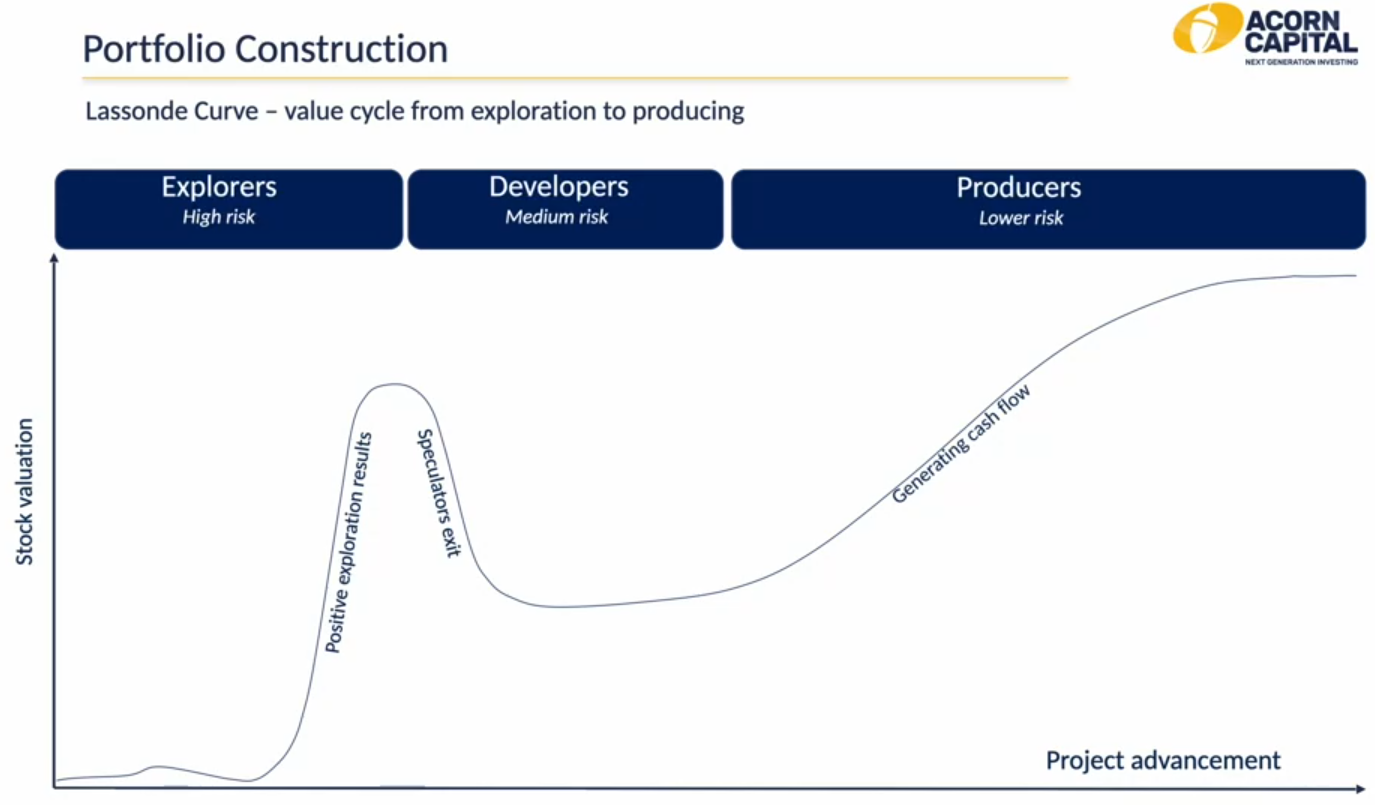Finding 1-in-100 mining stocks and why now is the time to be hunting for them
For most Australian investors, it’s the dream. Find a junior explorer or miner, pick up thousands (or millions) of shares for a pittance, and ride them to a valuation worth billions of dollars.
Think Poseidon Nickel (ASX: POS) back in the 70's and, more recently, Fortescue Metals (ASX: FMG) and some of the lithium plays.
But the sad reality is that most investors wouldn’t have a clue how to identify these stocks, let alone have a formula for how to invest in them, and therefore any windfalls are likely due to lady luck. Like anything, the skills required to be able to identify such opportunities take the best part of a lifetime to acquire and, even then, nothing is guaranteed.
“What skills?” I hear you asking.
25 years as a geologist and 10 years as a research fellow at prestigious universities is a good start. It’s also the profile of Rick Squire, Portfolio Manager (Energy and Resources) for the Acorn Capital NextGen Resources Fund - and a self-described “nerdy scientist”.
"When you're working at the small end of the market, particularly with the explorers where there's no resource, it's very difficult to evaluate what this company is," he says.
"For us, in the explorers where there are a lot of players and only a few of them cross the divide to become producers, that technical knowledge is absolutely paramount”.
As part of Livewire’s Undiscovered Fund Series, Squire shares:
- what it takes to identify up-and-coming mining and energy companies,
- why the process is part science and part art,
- why looking within the ASX-100 is a fool’s errand, and
- his formula for investing at the right time.
Squire also shares the commodities he believes have the biggest upside potential right now, how he is seeing deep value in a lot of smaller stocks, and one stock that stands out.
Please note that the following interview took place on Wednesday 31 May
The next opportunity in the commodities market
The Acorn NextGen Resources Fund was established within the last three years as the transition to the low-carbon economy really started to accelerate.
Whilst the last commodities supercycle was largely driven by the urbanization of China and commodities used in the production of steel - iron ore, coking coal, copper – energy transition will likely be driven by demand for commodities like lithium, rare earth elements, cobalt, and graphite.
As Squire points out, these are commodities that the current big mining companies don’t play in, and this is where Acorn comes in.
Acorn has been around for a little over 20 years and specialises in small companies and in niche markets, where those companies will grow into larger companies.
“There's a real opportunity and a real skillset that Acorn had, and so we saw it as an opportunity to draw out those skills and to provide a product to the market so people can take advantage, because you can't get exposure to that part of the market by investing in the ASX top 100”.
Hot commodities right now
When pressed for the three commodities that he thinks have the biggest upside, Squire was unequivocal.
- Lithium
- Rare earths
- Oil
Below is his thesis for each.
Lithium - Great demand whether you look at it in the short, medium, or long term. Despite the growth in the sector, it's actually very difficult to put mines into production. There are a lot of technical risks that the banks still haven't quite got their minds around. It's very difficult to raise capital in the debt markets for lithium projects. It requires that combination of technical and financial skills to evaluate projects because there's a variety of different deposits that contain lithium.
Rare earths - Used in the high-strength magnets in wind turbines and the drive mechanism in electric vehicles. At the moment it's estimated that 92% of all the high-strength magnets that are made in the world today, at some point in the manufacturing cycle, have had to pass through China. And so even if you put aside the US-China, Australia-China tension, what we've learned through COVID is that reliance on a single region or country for a commodity is just an unacceptable risk in the supply chain. There's a real focus to diversify that supply chain. So there's a great outlook, but there's a really important strategic outlook for rare earths.
Oil - We talked about the clean energy transition, but it's important to realise that this is a transition - it's not a big step that occurs tomorrow - and that oil will still be an important part of that transition. The nuance that we bring to that thinking is ‘if you're going to have oil or even gas, what are the projects that have the lowest carbon footprint for the production of the oil?’ We still see strong demand for oil, but we are thinking about it with that nuance of, which are the better projects in terms of their ESG criteria. And that's certainly working out well for us at the moment.
Let’s get technical – The Lassonde Curve

Whilst Squire outlines three commodities that he broadly likes, there is a game within the game when it comes to investing in junior energy and resource companies.
For that, Squire relies on the Lassonde Curve. As he explains it, “the Lassonde Curve is a graphical representation of the value cycle for resources and energy companies”.
More importantly, the curve provides a theoretical explanation of when to invest and when not to invest in explorers.
Put simply, you don’t want to hold all the way through the development from explorer to miner. There are periods where the share price will naturally fall away, like the period after an explorer makes a discovery, announces it to the market, and the share price shoots sharply higher.
What follows typically sees the early-stage investors, who have made 4, 5, or even 10x their money exit the stock, causing the share price to roll over.
Following that, there is a development phase where “there's a lot of risk around the resource risk, the mining risk, permitting risk, and it's not until it actually gets in construction that it finally achieves the maximum valuation”, says Squire.
“With that Lassonde Curve, we allocate an amount to those explorers where hopefully we get some really nice uplift, but we try to avoid that flat period or the falling part of the curve.
And then a large allocation to the stocks that are going through that growth period at the end. So it's lower risk, but still good returns”.
In terms of managing risk, Squire also relies on the Lassonde Curve to inform his decision-making.
“One of the areas we think about is once the discovery has been made, we want to ride and maximise that gain on the way up, but we put some discipline around selling and trimming into some of that strength, rather than getting a little bit swept up by the moment as many investors fall into that trap”.
The portfolio and a current stock opportunity
About 30% of the portfolio is currently invested in early-stage explorers and Squire highlights Patriot Battery Metals (ASX: PMT) as a prospective opportunity. Patriot is a lithium explorer operating in Northeastern Canada.
"They've made a really exciting discovery and we think it's got the potential to be a world-class discovery”, says Squire.
“There's no resource, and it's very difficult for some investors to quantify how big it could be. But again, this is where you think three-dimensionally.
“We look at the drill hole intercepts, we see how big they are, we see the grades, we think about the continuity of that resource, and the results so far are really outstanding”.
Whilst the opportunity is exciting, Squire is mindful of the risks – as all investors should be with these types of companies.
“There are risks around all these projects. So this one's in a very remote part of Canada. There are quite a few glacial lakes in the region. The lakes aren't very deep, but it's covered in lakes. So there are logistical issues, there are environmental issues that the company will face, but we think on balance it's still an exciting company”.
Finding the diamonds in the rough
Whilst there are no guarantees that any company will become the 1-in-100 bolter that everyone hopes it will be, Squire believes that the Acorn formula has tipped the odds in its favour.
“At Acorn, we've got a proven process of really using that combination of really strong financial and technical skills.
When you're working at the small end of the market, particularly with the explorers where there's no resource, it's very difficult to evaluate what this company is.
In the explorers where there are a lot of players and only a few of them cross the divide to become producers, that technical knowledge is absolutely paramount”.
Acorn Capital NextGen Resources Fund
Want to access a universe of Resources and Energy companies that are exposed to growth commodities? Click here to learn more, or visit their fund profile below.

3 topics
3 stocks mentioned
1 fund mentioned
1 contributor mentioned


